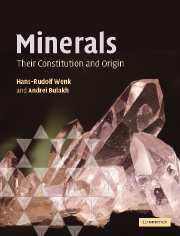Book contents
- Frontmatter
- Contents
- Preface
- Acknowledgments
- Figure credits
- Part I Structural features of minerals
- Part II Physical investigation of minerals
- Part III Variety of minerals and mineral-forming processes
- Part IV A systematic look at mineral groups
- 19 Important information about silica materials and feldspars
- 20 Simple compounds. Unusual mineral occurrences
- 21 Halides. Evaporite deposits
- 22 Carbonates and other minerals with triangular anion groups. Sedimentary origins
- 23 Phosphates, sulfates, and related minerals. Apatite as a biogenic mineral
- 24 Sulfides and related minerals. Hydrothermal processes
- 25 Oxides and hydroxides. Review of ionic crystals
- 26 Orthosilicates and ring silicates. Metamorphic mineral assemblages
- 27 Sheet silicates. Weathering of silicate rocks
- 28 Chain silicates. Discussion of some igneous and metamorphic processes
- 29 Framework silicates. Zeolites and ion exchange properties of minerals
- Part V Applied mineralogy
- Appendices
- Glossary
- References
- Index
- Plate section
- References
25 - Oxides and hydroxides. Review of ionic crystals
from Part IV - A systematic look at mineral groups
- Frontmatter
- Contents
- Preface
- Acknowledgments
- Figure credits
- Part I Structural features of minerals
- Part II Physical investigation of minerals
- Part III Variety of minerals and mineral-forming processes
- Part IV A systematic look at mineral groups
- 19 Important information about silica materials and feldspars
- 20 Simple compounds. Unusual mineral occurrences
- 21 Halides. Evaporite deposits
- 22 Carbonates and other minerals with triangular anion groups. Sedimentary origins
- 23 Phosphates, sulfates, and related minerals. Apatite as a biogenic mineral
- 24 Sulfides and related minerals. Hydrothermal processes
- 25 Oxides and hydroxides. Review of ionic crystals
- 26 Orthosilicates and ring silicates. Metamorphic mineral assemblages
- 27 Sheet silicates. Weathering of silicate rocks
- 28 Chain silicates. Discussion of some igneous and metamorphic processes
- 29 Framework silicates. Zeolites and ion exchange properties of minerals
- Part V Applied mineralogy
- Appendices
- Glossary
- References
- Index
- Plate section
- References
Summary
Introduction
The oxide and hydroxide groups each include about 200 minerals, or about 10% of all mineral species. We have discussed quartz and other silica minerals in Chapter 19. Quartz comprises nearly 12 vol.% of the earth's crust. Another oxide that is just as important as quartz is crystalline H2O (ice). This mineral occurs only as a “seasonal” phase at moderate latitudes, forms polar ice shields (crucial for the earth's climate), and glaciers. Besides its occurrence on the earth's surface, ice is one of the two major minerals building up the polar caps on Mars and has recently been documented on the moon. It is also found as particles forming the rings around Saturn, and may form a large part of the composition of some satellites of Saturn, Jupiter, and Uranus. Another important oxide is CO2, which does not occur on earth in the solid state but is present as a mineral on Mars and on the satellites of the outer planets, as well as in meteorites. In contrast to quartz and ice, iron oxides and hydroxides contribute only about 0.2% to the crust of the earth, but the minerals magnetite (Fe3O4) and hematite (Fe2O3) are the two major constituents of iron ores, and without iron the present state of our civilization is unimaginable.
- Type
- Chapter
- Information
- MineralsTheir Constitution and Origin, pp. 406 - 424Publisher: Cambridge University PressPrint publication year: 2004

